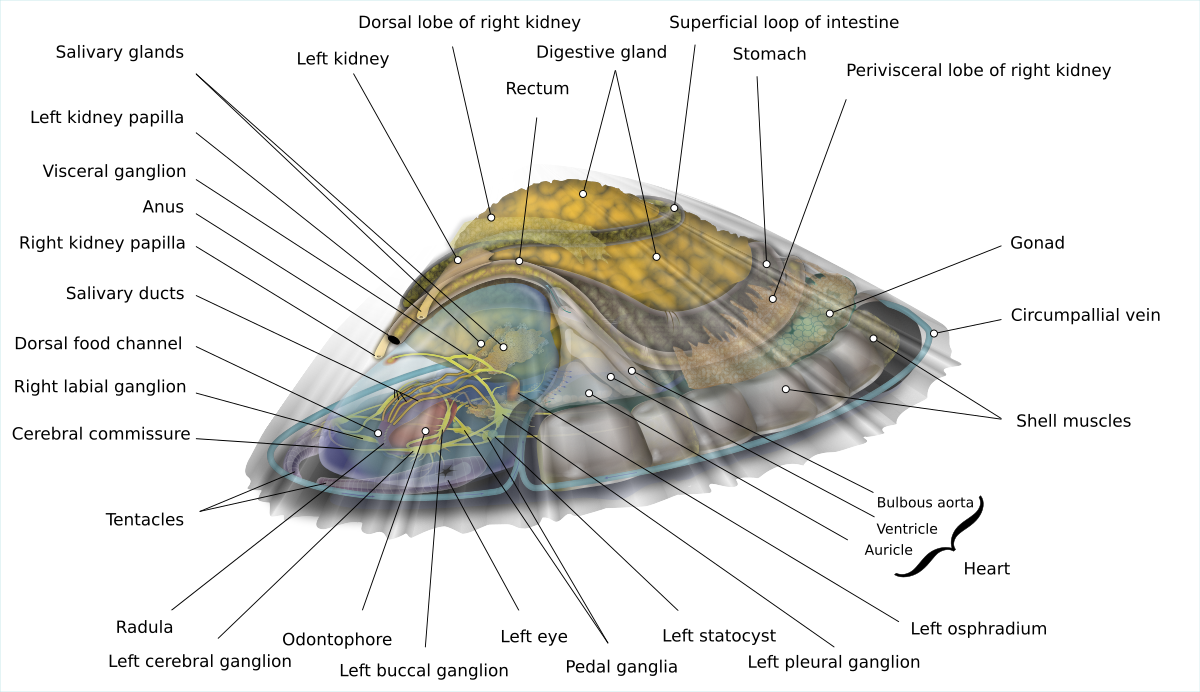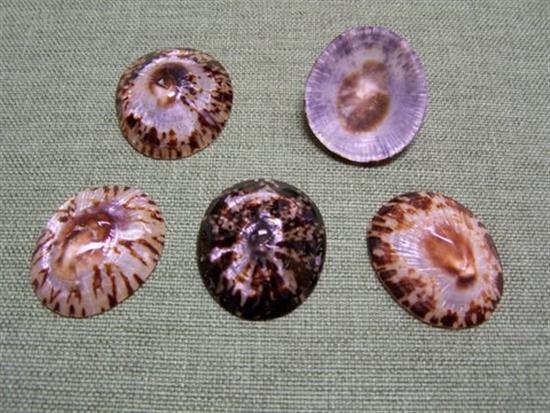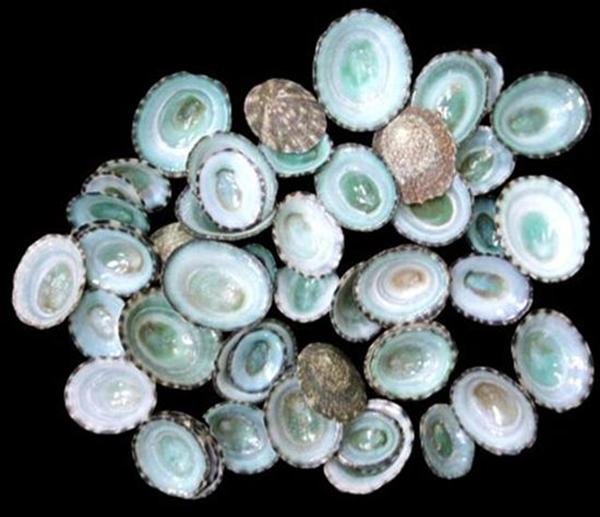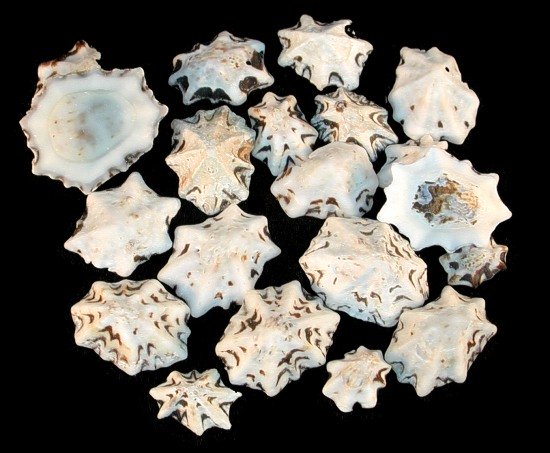As the site is updated, each listing includes the shipping cost. Some listings which I have not updated still give you calculated shipping costs based on weight and size of package. (In the sections I have updated) If you select several different listings, we will consolidate your order and charge you the actual cost of the entire package. The shipping over charge will be refunded to you, when your order is shipped.
LIMPET SHELLS
Limpets Shells
The following is from studies by James Richard Ainsworth Davis; Herbert John Fleure (1903). Patella, the Common Limpet. Williams & Norgate.
Limpets can grow up to 3 inches but most are 2 inches or less. They can be found worldwide.
Limpets are a group of aquatic snails that exhibit a conical shell shape (patelliform) and a strong, muscular foot. Limpets are members of the class Gastropoda, but are polyphyletic, meaning the various groups called limpets descended independently from different ancestral gastropods. This general category of conical shell is known as patelliform (dish-shaped). All members of the large and ancient marine clade Patellogastropoda are limpets. Within that clade, the members of the Patellidae family in particular are often referred to as "true limpets.
The basic anatomy of a limpet consists of the molluscan organs and systems.
A nervous system centered around the paired cerebral, pedal, and pleural sets of ganglia. These ganglia create a ring around the limpet's esophagus called a circumesophageal nerve ring or nerve collar. Other nerves in the head/ snout are the optic nerves which connect to the two eye spots located at the base of the cerebral tentacles (these eyespots, when present, are only able to sense light and darkness and do not provide any imagery), as well as the labial and buccal ganglia which are associated with feeding and controlling the animal's odontophore, the muscular cushion used to support the limpet's radula (a kind of tongue) that scrapes algae off the surrounding rock for nutrition. Behind these ganglia lie the pedal nerve cords which control the movement of the foot, and the visceral ganglion which in limpets has been torted during the course of evolution. The limpet's left osphradium and oshradial ganglion (an organ believed used to sense the time to produce gametes) is controlled by its right pleural ganglion and vice versa.
For most limpets, the circulatory system is based around a single triangular three-chambered heart consisting of an atrium, a ventricle, and a bulbous aorta. Blood enters the atrium via the circumpallial vein (after being oxygenated by the ring of gills located around the edge of the shell) and through a series of small vesicles that deliver more oxygenated blood from the nuchal cavity (the area above the head and neck). Many limpets still retain a ctenidium (sometimes two) in this nuchal chamber instead of the circumpallial gills as a means for exchanging oxygen and carbon dioxide with the surrounding water or air (many limpets can breathe air during periods of low tide, but those limpet species which never leave the water do not have this ability and will suffocate if deprived of water). Blood moves from the atrium into the ventricle and into the aorta where it is then pumped out to the various lacunar blood spaces / sinuses in the hemocoel. The odontophore may play a large role in assisting with blood circulation as well.
The two kidneys are very different in size and location. This is a result of torsion. The left kidney is diminutive and in most limpets is barely functional. The right kidney, however, has taken over the majority of blood filtration and often extends over and around the entire mantle of the animal in a thin, almost-invisible layer
The digestive system is extensive and takes up a large part of the animal's body. Food (algae) is collected by the radula and odontophore and enters via the downward-facing mouth. It then moves through the esophagus and into the numerous loops of the intestines. The large digestive gland helps break down the microscopic plant material, and the long rectum helps compact used food which is then excreted through the anus located in the nuchal cavity. The anus of most mollusks and indeed many animals is located far from the head. In limpets and most gastropods, however, the evolutionary torsion which took place and allowed the gastropods to have a shell into which they could completely withdraw has caused the anus to be located near the head. Used food would quickly foul the nuchal cavity unless it was firmly compacted prior to being excreted. The torted condition of the limpets remains even though they no longer have a shell into which they can withdraw and even though the evolutionary advantages of torsion appear to therefore be negligible (some species of gastropod have subsequently de-torted and now have their anus located once again at the posterior end of the body; these groups no longer have a visceral twist to their nervous systems)
The gonad of a limpet is located beneath its digestive system just above its foot. It swells and eventually bursts, sending gametes into the right kidney which then releases them into the surrounding water on a regular schedule. Fertilized eggs hatch and the floating veliger larvae are free-swimming for a period before settling to the bottom and becoming an adult animal.
True limpets in the family Patellidae live on hard surfaces in the intertidal zone. Limpets are capable of locomotion instead of being permanently attached to a single spot. When they need to resist strong wave action or other disturbances, limpets cling firmly to the surfaces on which they live, using their muscular foot to apply suction combined with the effect of adhesive mucus. It often is very difficult to remove a true limpet from a rock without injuring or killing it.
All true limpets are marine. The most primitive group have one pair of gills, in others only a single gill remains, the lepetids do not have any gills at all, while the patellids have evolved secondary gills as they have lost the original pair. However, because the adaptive feature of a simple conical shell has repeatedly arisen independently in gastropod evolution, limpets from many different evolutionary lineages occur in widely different environments. Some saltwater limpets such as Trimusculidae breathe air, and some freshwater limpets are descendants of air-breathing land snails (e.g. the genus Ancylus) whose ancestors had a pallial cavity serving as a lung. In these small freshwater limpets, that "lung" underwent secondary adaptation to allow the absorption of dissolved oxygen from water.
Patellidae Scientific classification
Domain: Eukaryota
Kingdom: Animalia
Phylum: Mollusca
Class: Gastropoda
Subclass: Patellogastropoda
Super family: Patelloidea
Family: Patellidae
Rafinesque, 1815


Oval Limpet Hawaiian Limpet
HL4-15
Three polished Hawaiian oval limpet shells, measuring 2.25 and 2 1/2 inches...... $5.95
xHL4-15
Seven polished Hawaiian oval limpet shells, measuring 2.25 and 2 1/2 inches...... $11.95
xxHL4-15
Twelve polished Hawaiian oval limpet shells, measuring 2.25 and 2 1/2 inches...... $17.95
xxxHL4-15
Twenty five polished Hawaiian oval limpet shells, measuring 2.25 and 2 1/2 inches...... $30.95
HL3-15
Three oval, polished Hawaiian Limpet shells, measuring 1.75 and 2 inches...... $6.75
xHL3-15
Seven oval, polished Hawaiian Limpet shells, measuring 1.75 and 2 inches...... $11.75
xxHL3-15
Twelve oval, polished Hawaiian Limpet shells, measuring 1.75 and 2 inches...... $16.75
xxxHL3-15
Twenty five oval, polished Hawaiian Limpet shells, measuring 1.75 and 2 inches...... $28.95
HL2-15
Three polished Hawaiian oval limpet shells, measuring 1.5 to 2 inches...... $6.75
xHL2-15
Seven polished Hawaiian oval limpet shells, measuring 1.5 to 2 inches...... $10.95
xxHL2-15
Twelve polished Hawaiian oval limpet shells, measuring 1.5 to 2 inches...... $14.75
xxxHL2-15
Twenty five polished Hawaiian oval limpet shells, measuring 1.5 to 2 inches......$24.75
HL1-15
Three Polished Hawaiian Oval Limpet Shells, measuring 1 to 1 1/2 inches..... $6.95
xHL1-15
Seven Polished Hawaiian Oval Limpet Shells, measuring 1 to 1 1/2 inches..... $10.25
xxHL1-15
Twelve Polished Hawaiian Oval Limpet Shells, measuring 1 to 1 1/2 inches..... $13.45
xxxHL1-15
Twenty five Polished Hawaiian Oval Limpet Shells, measuring 1 to 1 1/2 inches..... $21.95

Green Limpets
Green Limpets are gastropods (mollusks that create a single shell to live in), they attach themselves to rocks in the intertidal waters. These are excellent craft shells. In all, there are more than 400 species. Most are found in temperate waters distributed worldwide.
HH2-15
Three Green Limpet shells, measuring under an 1 inch, a few may be an inch........$5.95
xHH2-15
Seven Green Limpet shells, measuring under an 1 inch, a few may be an inch........$7.95
xxHH2-15
Twelve Green Limpet shells, measuring under an 1 inch, a few may be an inch........$9.95
xxxHH2-15
Twenty five Green Limpet shells, measuring under an 1 inch, a few may be an inch........$14.95
xxxxHH2-15
Fifty Green Limpet shells, measuring under an 1 inch, a few may be an inch........$23.25
xxxxxHH2-15
One hundred Green Limpet shells, measuring under an 1 inch, a few may be an inch........$39.95

Star Limpets
Patelloida Lottidae, Star Limpets sometimes called the Pacific Sugar Limpet. These are gastropods (mollusks that create a single shell). They have seven or eight strong radiating ridges, with lesser ridges between, crossed by irregular concentric growth lines. They attach themselves to intertidal rocks. These are excellent craft shells. In all, there are more than 400 species. They are found in the Indo-Pacific region from the east Indian Ocean to the Northern Australian/New Zealand shores.
X1-10
One quarter pound of Star Limpet shells, measuring up to to 1 inch..... $5.75
-X1-10
One half pound of Star Limpet shells, measuring up to to 1 inch..... $8.65
--X1-10
One pound of Star Limpet shells, measuring less than 1 inch, a few may be an inch.... $14.95